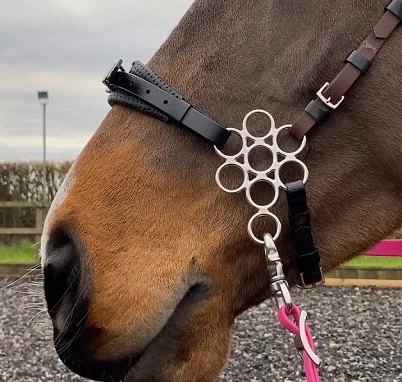Bridles are a type of leather headgear used to control horses. Traditional bridles include a bit, usually a piece of metal that sits directly on the sensitive tissue of the horse’s mouth.
While most horse riders still use bitted bridles, there is a rising awareness that bits can cause discomfort and pain to the horse. Therefore, more and more riders are looking for alternatives to the traditional bridle.
In many ways, the hackamore bridle is an ideal replacement as it gives you no less control over the horse. However, it also comes with its own set of negatives riders should take into account before switching to a hackamore bridle.
What is a Hackamore Bridle?
A hackamore bridle is a type of bitless bridle that uses leverage action to control the bit. It consists of a padded noseband that attaches to shanks on either side and a curb chain or strap running underneath the horse’s jaw.
The word “hackamore” comes from the Spanish word “jáquima”, which means halter or headstall. Hackamores are most popular in western riding, but also appear in English disciplines like show jumping and eventing.
Although hackamore bridles are quite a modern invention, similar pieces of equipment were already used shortly after the domestication of the horse, around 4,000 BC. These primitive hackamores were no more than a piece of rope wrapped around the horse’s nose.
Hackamores were also the forerunners of bits and bridles that only appeared around 1,000 BC.
Also, read our guide on what horse bits are and how they work.
How Hackamore Bridles Work
Hackamore bridles work much the same way as regular curb bits. They use leverage action to amplify the rider’s aids and put pressure on the chin, nose, and poll.
The severity of a hackamore is determined by the length of the shanks and the width of the noseband. Longer shanks exert greater force on the horse’s muzzle, while thinner nosebands concentrate pressure on the bridge of the nose.

vprotastchik / Shutterstock.com
While hackamores are highly efficient in stopping the horse, they cannot transmit turning aids as well as a bit or other bitless bridles. Therefore, the horse must be more responsive to seat and leg aids when ridden in a hackamore.
Unlike traditional horse bridles, hackamores don’t require the rider to maintain constant contact via the reins. Contact is only picked up when the rider applies rein aids and instantly removed once the horse has responded.
Because of their power and poor steering, hackamore bridles are only permitted in a limited number of disciplines. These include rodeos, gymkhanas, show jumping, eventing, endurance, and competitive trail riding. They are also particularly popular with hunters and leisure riders.
Also read: 20 True or False Horse Quiz Questions
Hackamore Bridle Pros and Cons
If used for the right reasons by an experienced person, hackamore bridles can be great tools for improving the communication between horse and rider. However, their power can be very easily abused, which is why hackamores should never be used to gain more control over the horse.
Here are the main pros and cons of hackamore bridles:
Pros:
no bit in the horse’s mouthideal for horses with injuries to the mouthpreferred by some horsesgood control over the horsethe horse is able to eat and drink with the bridle on
Cons:
difficult to turn the horsecan cause headshaking/head-tossingmay damage the nose in rough handscan interfere with breathing What’s the Difference Between a Hackamore and a Bitless Bridle?
The difference between a hackamore and a bitless bridle lies in their mode of action. Hackamores use leverage to exert pressure on the horse’s nose and jaw, while bitless bridles work via direct pressure.
Because of their mechanism of action, hackamores are much more severe than other bitless bridles. With a side pull or a cross-under bitless bridle, for example, a 20 lbs rein signal will transmit 20 lbs of force to the horse’s head. Whereas, a hackamore with 4-inch shanks will increase that force to 80 lbs.
Is a Hackamore More Gentle Than a Bit?
It’s a common misconception to believe a hackamore is more gentle than a bit. Depending on its use, a hackamore can be as harsh as a bit as it applies great force to the soft and sensitive facial structures.

horsemen / Shutterstock.com
The horse’s face is very well innervated, which is why hackamores are so effective in the first place. They sit directly on top of the largest superficial nerve of the horse’s head, the trigeminal nerve. This explains why the harsh use of hackamore bridles can trigger headshaking in horses.
However, not all hackamores have the same severity. Some designs with shorter shanks can be quite mild as they don’t use as much leverage. Meanwhile, hackamores with very long shanks paired with a curb chain can magnify rein pressure to such an extent that may even fracture the horse’s jaw.
Also read: Are Horse Bits Cruel?
Common Types of Hackamore Bridles
So far in this article, we have focused on mechanical hackamores that use leverage action on the horse’s nose. However, there are also non-mechanical hackamores like the bosal and side pull that act via direct pressure.
Some sources claim that true hackamores don’t use leverage action, however, the word has become common when referring to mechanical hackamores. As a result, we have also adopted the term when discussing mechanical hackamores throughout the article.
There are a few different types of hackamore bridles on the market that apply varying levels of pressure to the horse’s head:
Classic Hackamore

Rolf Dannenberg / Shutterstock.com
The classic hackamore is the most common type of hackamore bridle out there. It has shanks that are slightly curved, which makes it less severe than hackamores with straight shanks.
Most classic hackamores also have a leather noseband with fleece lining for extra comfort. A chain or leather strap under the chin completed the noseband of the hackamore.
Various designs of the classic hackamore exist, such as the Engish and German hackamore. While the English design has medium-length shanks, German hackamores have very long shanks (over 7 inches) that are slightly curved and connected with a thin metal bar at the end.
S Hackamore

Credit: Zilco International
The shanks of S hackamores are highly curved, making them less severe than classic hackamores. This design is popular with endurance and trail riders, as it allows the horse to easily eat and drink in the bridle.
S hackamores typically feature a padded leather noseband and leather chin straps. Some riders found it easier to steer the horse and used less pressure with an S hackamore.
Flower Hackamore

Credit: Zilco International
As the name suggests, the shanks of this hackamore have the shape of a flower, offering multiple placement options for the noseband and reins. This unique design allows riders to increase or decrease the strength of the hackamore as needed.
As a rule, the lower the reins attach to the shanks, the more pressure they can exert on the nose. On the other hand, moving the reins higher will decrease the leverage action and severity of the hackamore.
The flower hackamore is relatively mild compared to other designs. It comes in both a short version with 7 rings or a long version with 8 rings.
Pinwheel Hackamore

Instead of shanks, the noseband of a pinwheel hackamore attaches to a metal ring with 6 slots for straps. This offers some adjustability as to where the parts of the bridle can go.
Similar to the pinwheel design is the star wheel hackamore that features a star in the center of the rings. Both are a mild type of hackamore.
Love Hackamore

The love hackamore has very short shanks no longer than 4 inches in length, and is the mildest type of hackamore. It’s typically used with ponies or horses that don’t need a powerful bridle.
Should You Use a Hackamore Bridle?
Hackamore bridles certainly have their uses and can come in handy in various situations. For example, if you’re riding a strong horse that has learned to ignore the bit, hackamores can open a new and more effective channel of communication.
Another common reason why riders may switch to hackamore bridles is issues in the horse’s mouth. If your horse has suffered an injury to his tongue, teeth, or jaw, it may no longer be able to accept the bit.
Hackamore bridles can also be useful in the winter, when freezing temperatures can irritate the mouth of horses wearing a metal bit.
Moreover, behavioral problems triggered by bits like head shaking, rearing, or excess salivation have also improved with hackamores in the past. However, hackamores can also create these problems if used harshly, or the rider’s hands aren’t quiet.
Therefore, you should try out other bitless bridles before trying on a hackamore when considering going bitless.
Side pulls, bosals, and cross-unders can be just as effective in improving your communication and relationship with your horse. Not to mention they are much kinder to the horse than a hackamore.

What Type of Hackamore Should I Use?
You should always use the mildest possible type of hackamore on your horse. Perhaps start with a love or pinwheel hackamore and gradually move up to longer shanks if necessary.
Remember to always introduce a hackamore bridle slowly as your horse might find the different aids and pressure points strange and confusing at first.
Plenty of groundwork like leading, luging, or long reining is highly recommended to allow your horse time to adjust.
Once your horse got used to the feeling of the hackamore on the ground, he is ready to progress to ridden work. Keep in mind that you will need a light contact and steady hands when riding in a hackamore.
Source: horseyhooves.com








